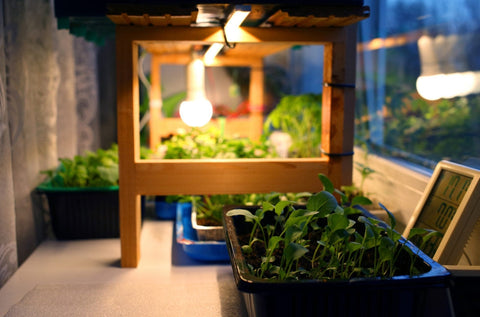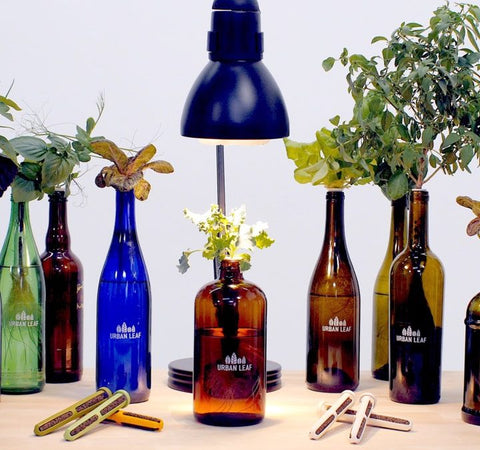Grow lights are one of the most important parts of an indoor gardening setup, especially if what you’re trying to grow is edible. But with many options available, and so much technical mumbo-jumbo being used by manufacturers, figuring out the right option for you can be an overwhelming task.
The purpose of this article is to simplify your grow light purchasing experience. We will look at some of the most common types of grow lights, and tell you what to look for in each. We also include some links at the end to purchase these products, if you’re interested.
Grow Lights For SMALL Indoor Gardens
For small garden setups consisting of 1-3 herbs or maybe 1-2 fruiting/flowering plants, we recommend either a screw-in bulb with your own lamp or a free-standing setup. Let’s take a closer look at each.
Screw-In Grow Light Bulb (E26 fitting) for Indoor Gardens
Screw-in grow light bulbs offer the most affordable way to get into grow lights. For as little as ~$15, you can buy a very reasonable, full-spectrum bulb. If you’re able to make use of an existing pendant or desk lampstand that you already have lying around at home, then that $15 might be all you need to spend.

One of the main benefits of this approach is that a screw-in bulb is very easy to integrate with the decor of your home. They will typically have a common E26 screw-in fitting that is compatible with pretty much any desk lamp or pendant light fitting. Just keep in mind that grow bulbs for plants are usually a bit ‘bulkier’ than the regular light bulbs you’d use to illuminate your home, so avoid housings that are very small or thin.
Our other tips and recommendations include:
Choose a bright white color globe over purple
Trust us, the novelty factor of a purple light wears off after about 15 minutes, and as we explain in ‘Why You Should Not Buy A Purple Grow Light’, they simply aren’t necessary.
Choose a LED globe over a CFL (compact fluorescent)
LEDs generally offer better light intensity plus a lower total cost of ownership (i.e. initial purchase price PLUS long term cost of energy to run them)
Look for options that include optics
We prefer grow light bulbs that include optics, mainly because they help ‘channel’ the light towards the plant and reduce light spillage.
Some of our favorite screw-in globes include:
Note: many of the product links in this blog are affiliate links. You will pay no more by using them to make your purchase, however, we do make a small commission that helps pay our bills so we can spend time writing blogs like this one.
Of course, if you don’t already have a lampstand then you’re going to need to buy one of those too. Turning the unit on and off every day is also made much easier with an automatic timer. These additional components are not super expensive, and in this video, we show you how to source all the components for less than $40.
Free-Standing Grow Light Setups
The main benefit of these units is their ‘all-inclusive’ nature. They are ready to go straight out of the box, and some will even come with an integrated timer (saving you $10-15).

A lot of what you’re paying for with these units is the stand, housing, and connection as opposed to the light itself. So if you happen to find one that works well with your space then great – go for it – but if you feel like you’re compromising on aesthetics with a unit like this then our advice would be to put your $’s into the grow light itself (and buy a bulb, above) and spend less of your available budget on the stand.
Our other tips and recommendations include:
Look for adjustability
Light degrades quickly with distance (as we explain in Grow Lights For Indoor Plants – How To Measure It, and Understanding Watts, PPF, PPFD, and DLI) so it is important that as your plants grow you are able to move the light with them. For this reason, we are not particularly fond of units that have a ‘fixed’ height.
Avoid units that have a USB socket
Although the common USB is a convenient way to power your grow light, manufacturers use them because they are cheap to supply, and not because they are well suited for grow lights. Why? USB sockets are generally limited to 5V and 2 Amps. That means that the maximum power you can get from them is 10W. That’s not a lot of power for a plant grow light, and we find that many USB powered units are underpowered for edible plants.
Some of our favorite free-standing light units for plants are listed below.
Root Farm

|
 |
Torchstar – can be used without the stand/base by using double sided tape under shelf/cabinet.
Grow Lights For MEDIUM Sized Indoor Gardens
The setups above are typically good for 1-3 plants, but if that’s a bit on the small side for you then the next logical place to look is a grow bar or strip light. You will find two types of these:
- Fluorescent tubes (T5’s are popular amongst gardeners). These are cheaper to buy but more expensive to run.
- LED strips. These are more expensive to buy but cheaper to run.

Whether you chose a fluorescent tube of LED, when you get into these sorts of units you are moving from ‘hey, look at my cute little garden on the counter’ to, ‘hey, I’ve got something pretty serious going on here’.
Strip (LED) grow lights come in lengths of 1 – 4’ (30- 120cm), and come in a range of form factors and housings. Some are pretty minimal, others are a fair bit bulkier.
Our other tips and recommendations include:
Check If they come with mounting hardware
These sorts of units are going to need to be mounted underneath a shelf or cabinet. This could be done with hooks, chains, cables, or some combination of all three. Check to see if the unit comes with this stuff. Not the end of the world if it doesn’t, but keep in mind that a trip to Home Depot may be in your future if not.
Daisy-chaining is handy
Look for a unit that allows you to daisy chain units end to end. This means that with a single plug into the wall, you can connect these units to themselves to expand your setup. If you’re anything like us then chances are you’re going to get pretty carried away with your gardening and it won’t be long before you’re looking to expand it. When and if that happens, you will be glad your lights can daisy-chain.
Choose LED over Fluorescent
The ‘original’ strip/bar lights all used fluorescent tubes, and it is, therefore, fluorescent tube sizing that has established many of the sizing and housing standards in this space. You will, for example, find LED lights that are sized to fit exactly in a fluorescent housing – right the way down to the connectors. This allows for easy retro fitting of LEDs. Aside from avoiding a few dollars upfront, there is literally no reason at all to start with flouros. The few dollars you save initially will be quickly recovered (and some) by the lower energy use of LEDs. What’s more, LEDs typically offer a better light spectrum, run at cooler temperatures, and offer far more color options.
Choose a bright white color globe over purple
Trust us, the novelty factor of a purple light wears off after about 15 minutes, and as we explain in ‘Why You Should Not Buy A Purple Grow Light’ (coming soon) they simply aren’t necessary.
Newer over older
LED lighting technology is moving very fast. In as little as a year, a new generation of LED chips can come out that offer better efficiency and longevity. Look for more modern units, or ask the manufacturer when was the last time they upgraded the LED chips in the unit they are selling.
Some of our favorite mid-size grow bars are listed below.

|
 |
Barrina MARS HYDRO
Grow Lights For LARGE Sized Gardens
If you’re reading this section, then chances are you’ve developed a reputation amongst your family and friends as the crazy plant lady (or guy) of your group. Hey, you’re welcome here – but your uninitiated friends are likely to raise an eyebrow when they come over for the first time. These sorts of grow lights are good for illuminating grow areas that might be 4 – 12 square feet in size.

There are three main types of grow lights to choose from for large setups.
LED panels
These start at around 10×10″ square in size (good for a 2 x 2′ to 3 x 3′ grow area), but you can get much larger options which of course increase the grow area. Unlike the strips which we included above, LED panels are intended for a much wider grow area. You could also include LED strips and bars here, but you’ll likely need to run more than one in parallel (another reason why daisy-chaining is useful, by the way).
Metal Halide
Metal halide globes work by passing an electrical current through a mix of metal halide gas and mercury. Be careful with the potential exposure to mercury if you decide to go this route. The light they emit is closer to ‘white’ in color. Metal Halide is better suited for vegetative growth.
High-Pressure Sodium
High-Pressure Sodium (HPS) lights are more yellow/amber in color and one main benefit is that you avoid having mercury in your home! HPS is also more economical to run. HPS is better suited for flowering, due to them having more red spectrum. You may find that larger scale or commercial growers use a combination of both Metal Halide and High-Pressure Sodium so that they cover both bases.
If we can be totally honest, we don’t really have a whole lot of experience with these sorts of lighting setups. About all we can tell you about the units below is that we have heard good things about them, and they seem to be popular. We have not used them personally.

LED panel
Includes both a Metal Halide and High Pressure Sodium bulb

A smaller and more affordable HPS option
Other considerations or large Grow Light setups
Whichever of these three options you choose, you are likely to need to set aside a dedicated grow area in your home. This could be an entire room, or just a grow tent. We’re talking about hundreds of watts worth of light here – this is not the sort of thing you are going to want sitting next to you when you’re trying to cook dinner or watch TV.
If you’d like to learn more about grow lights or growing an indoor garden, then head on over to our Indoor Edible Gardening Library for guides, calculators, and more. It’s 100% free and designed to teach you what you need to know to grow your own food at home. For our latest deals, promotions, and freshest content – sign up for our newsletter below.














There are no comments for this article. Be the first one to leave a message!